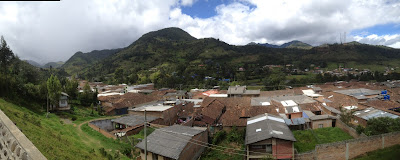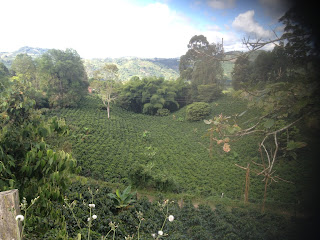Was awesome! We had three weeks total. Technically, it was "winter" break in Colombia, as the long break comes during our winter, from December through February.
A girl in my group, Natasha, and I decided to take advantage and explore more of Colombia for about a week before my mom came to visit. We took a Colombian "road trip" in the southern region, starting in the Salsa Capital of the world, Cali, and working our way southeast to San Agustin.
 Cali is difficult to describe. It is very big-- several million people -- but unlike any other city in Colombia. It is somehow a little grittier than Bogota or Medellin, but also more rewarding once you get to know it.
Cali is difficult to describe. It is very big-- several million people -- but unlike any other city in Colombia. It is somehow a little grittier than Bogota or Medellin, but also more rewarding once you get to know it.The climate is cooler than on the coast but the days are still hot under the sun. The entire region is beautifully green. From Cali to San Agustin, we saw many green grassland valleys with palm trees, green mountains and rolling hills. Awesome countryside for a road trip!
We arrived in Cali on a Saturday night and decided to take advantage of the city's reputation and try our hand at salsa dancing.
 |
| Natasha hangin out at the top of a hill in Cali |

The next day, we ventured out to explore, including the historical colonial area. This picture to the right doesn't quite capture it, but we had a magical moment with the owner of a pinwheel shop. Pinwheels are a tradition in Cali as a gift for children from their godparents. Neither Natasha or I knew this before showing up in Cali, but we kept seeing them pop up everywhere -- in public art, on signs and displays, and beautiful ones spinning in the breeze like these ones out of this man's shop. We both bought one, even though it was a giant pain to carry around with our big backpacks.

 The day after, we headed out to Popayan, which is Colombia's "whitest" city haha. The entire colonial downtown is totally white buildings, and very beautiful in the sunlight.
The day after, we headed out to Popayan, which is Colombia's "whitest" city haha. The entire colonial downtown is totally white buildings, and very beautiful in the sunlight.
We spent an afternoon wandering, photo-taking and trying to find the best local food specialties.


The day after that, we decided to take a bus to Silvia, a much smaller town up in the mountains where we were told there was a great, lively market.

 And there was! Silvia was also just so green and gorgeous. We had a super authentic market meal alongside Silvia's indigenous population (think Bolivian indigenous clothing) and ran around the market for a while before walking up to a church for some more great photos.
And there was! Silvia was also just so green and gorgeous. We had a super authentic market meal alongside Silvia's indigenous population (think Bolivian indigenous clothing) and ran around the market for a while before walking up to a church for some more great photos.
Here's a bunch of photos, just 'cause it's so pretty!
We finally made our way down to San Agustin after a rocky and long bus ride. We stayed in a hostel at the top of the hill and actually befriended a few backpackers to go check out the ancient statues that draw tourists.

The statues were amazing, but the countryside was even better! San Agustin was a tiny town and it was fun to walk around downtown as well. We ate some good food and after a few days packed it up to head home so that I could meet my mom!!

Sooooo pretty!!!




The day after that, we decided to take a bus to Silvia, a much smaller town up in the mountains where we were told there was a great, lively market.

 And there was! Silvia was also just so green and gorgeous. We had a super authentic market meal alongside Silvia's indigenous population (think Bolivian indigenous clothing) and ran around the market for a while before walking up to a church for some more great photos.
And there was! Silvia was also just so green and gorgeous. We had a super authentic market meal alongside Silvia's indigenous population (think Bolivian indigenous clothing) and ran around the market for a while before walking up to a church for some more great photos.Here's a bunch of photos, just 'cause it's so pretty!
 |
| Our traditional lunch |
We finally made our way down to San Agustin after a rocky and long bus ride. We stayed in a hostel at the top of the hill and actually befriended a few backpackers to go check out the ancient statues that draw tourists.

The statues were amazing, but the countryside was even better! San Agustin was a tiny town and it was fun to walk around downtown as well. We ate some good food and after a few days packed it up to head home so that I could meet my mom!!

Sooooo pretty!!!








